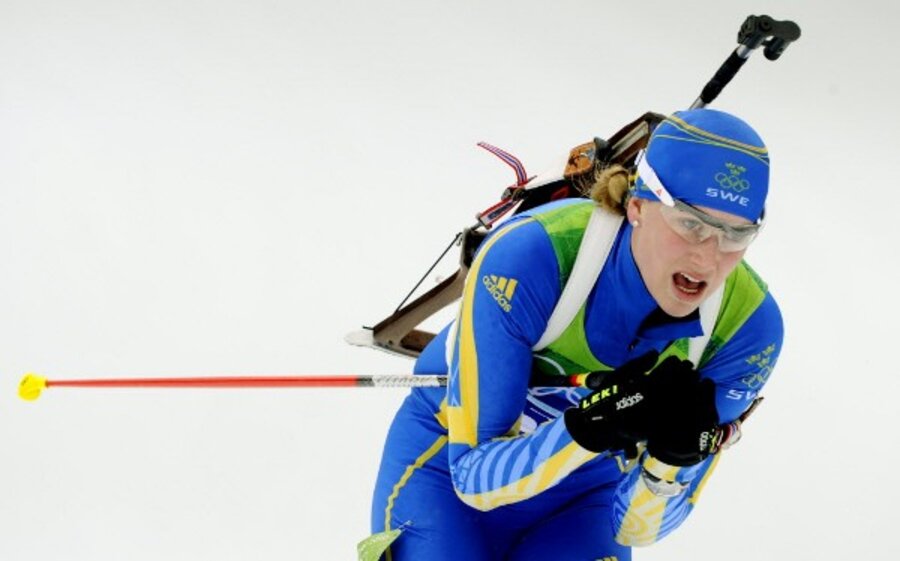Winter Olympics: Why biathlon is the most popular sport in Europe
Loading...
| Whistler, British Columbia
When Magdalene Neuner took an Olympic silver medal in the biathlon sprint event today, you can be sure her fellow Germans were tuning in.
Though seen as an exotic enigma by most Americans, biathlon has become the No. 1 winter sport to watch on TV in Europe.
That’s no small feat in countries such as Germany and Sweden, with strong traditions in skiing. But when lycra-clad biathletes are flying through packed stadiums, shooting targets the size of golf balls from half a football field away – all while their heart is racing and their chest heaving – 20 million people across Europe tune in for the prime time coverage.
Biathletes from Helena Jonsson – a classic Swede except perhaps for her love of Desperate Housewives – to Germany’s Kati Wilhelm have been voted athlete of the year by their countrymen.
“Five, six, seven years ago, more people were watching alpine skiing and cross-country,” says Johanna Reimers, a journalist with Sweden’s second-largest daily, Expressen. “Now, biathlon is the biggest TV winter sport in Sweden, and that’s all Helena.”
Roaring fans despite soggy weather
When the popular Swede, currently ranked No. 1 in the world, sprung out of the start gate at Whistler Olympic park Saturday afternoon, a huge contingent of blue-and-yellow clad countrymen roared in the stadium. Even some of her Olympic teammates in curling and ice hockey made the trek from Vancouver to Whistler to see her perform.
Unfortunately, despite feeling good going into the race she was a disappointing 12th . But German fans, who regularly follow the World Cup over pastries and cheese on weekend mornings, were thrilled with Neuner taking second to Anastazia Kuzmina of Slovakia.
It was also good news for German state TV outlet ZDF, which regularly brings 25 cameras and a crew of 100 people to World Cups, says ZDF chief Andreas Lauterbach.
Lauterbach has worked for ZDF since 1994, and says the tilt toward biathlon began in the mid- to late-90s when German biathletes became Olympic champions. Then, when the country’s popular ski jumpers faltered in 2002-04, biathlon skipped ahead – helped by new head-to-head racing formats that were exciting for spectators.
That excitement has not only doubled television audiences for biathlon in the past four years, according to the European Broadcasting Union (EBU), it has also attracted huge crowds to World Cups.
In Germany earlier this year, 35,000 people came out to watch the World Cup in Oberhof, whereas only 3,500 had attended the cross-country World Cup a week earlier. (By comparison, a little over 4,000 turned out for the Olympic race today.)
“Sometimes people scream right behind you when you make a shot, or when you miss a shot,” says No. 1 ranked Simon Fourcarde of France, where biathlon is barely on the radar.
500 percent increase in TV rights fees
Capitalizing on such interest, the International Biathlon Union received a 500 percent increase in rights fees when it renewed its four-year contract with EBU for 2006-2010. Instead of the previous 7 million euros, they secured 40 million euros from the umbrella organization that serves public broadcasters eager for more shoot-and-ski action.
But TV’s dependence on one sport, determined by the rise and fall of a country’s athletes, isn’t healthy, says German journalist Christine Kamm.
“They always tend to push one sport and neglect all the others,” says Kamm, adding that when top international figure skater Sarah Hecken won German Championships in Mannheim earlier this season, even the regional TV station didn’t broadcast the event – focusing instead on soccer.
“Instead of half an hour of soccer and 10 minutes of the best of the rest, they will always go soccer, soccer, soccer,” says Kamm.
But exciting formats and top athletes doesn't translate into lots of TV time everywhere. France had an outstanding performance in today's biathlon sprint, with rookie Marie Dorin winning bronze and teammate Marie Laure Brunet taking sixth.
"In Italy [at the 2006 Games], we won four medals, but that didn't change anything," says team leader Christian Dumont.
That didn't keep the team from celebrating a totally unexpected podium performance from Dorin, with coaches slapping each other on the back and reveling in their success.
How to watch biathlon
For the uninitiated, biathlon can seem a bit bewildering. Read a simple synopsis of the formats here.






